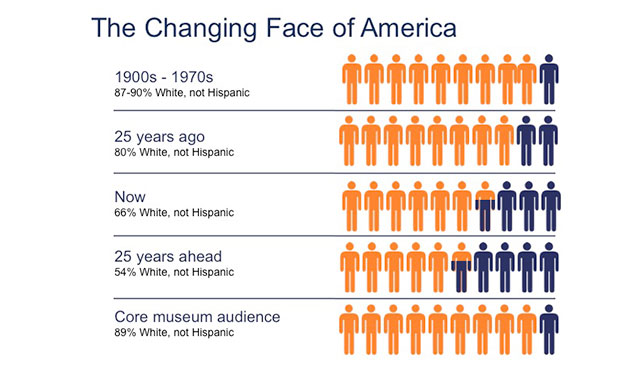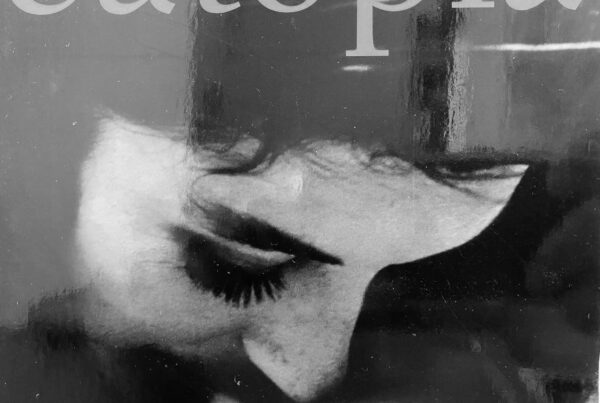President Obama’s reelection last week has put a blazing spotlight on the “emerging majority” thesis, thrusting it into the center of political discussion. Some pundits, including prominent Republicans, even question the party’s future if they don’t change their race-baiting ways and embrace the reality of a multicultural America. As the Economist put it, “The GOP must become younger and browner to remain a serious contender.” Would it surprise you to know that, on this score at least, the liberal-leaning art world has more in common with Republicans than Democrats?
For make no mistake about it, the “emerging majority” thesis has great significance for art and its institutions. Cosmopolitan New York is a majority minority city, and has been for as long as anyone can remember. But walk from the subway towards any gallery opening or museum party, and watch the color drain away. In fact, for some time now, the people who crunch the data on cultural participation have been warning that the art world’s inability to address this issue threatens its very future.
Back in 2010, the Center for the Future of Museums (CFM) issued a report with a title at once anodyne and urgent: “Demographic Transformation and the Future of Museums.” It is well worth reviewing in depth for what it says about the scandalous state of diversity in the visual arts, but its moral is really all summed up in the following line: “This analysis paints a troubling picture of the ‘probable future’ — a future in which, if trends continue in their current grooves, museum audiences are radically less diverse than the American public, and museums serve an ever-shrinking fragment of society.”
The data tells the story. As of 2008, non-Hispanic whites made up close to 80 percent of visitors to museums, even though they were only about 70 percent of the population. Another study, by Reach Advisors, polled 40,000 museum-going households. Among those who frequented art museums, a stunning 92 percent identified as white, and only 16 percent identified as a minority (in this survey, respondents were allowed dual identification). Compare: 87 percent of registered Republicans are white.
It is amazing how insulated from this issue the art world has been. When New York magazine recently wrote its “New Art World Rule Book” and included one (shamefacedly un-bylined) piece advising artists that the secret to success was, “Be Young, Post-Black, and From Chicago” (citing just two figures, Theaster Gates and Rashid Johnson), it rang out as thoroughly clueless. But the high-minded mandarins of contemporary theory don’t score so much better. Infamously, when Yve-Alain Bois, Benjamin Buchloh, Hal Foster, and Rosalind Krauss wrote their textbook, “Art Since 1900,” they penned every chapter themselves — except for the two on communities outside the normal October School narrative, Mexican muralism and the Harlem Renaissance, which were outsourced to a writer credited only by his/her initials. You think this might be a signal about whose history counts?
The cringe-worthy statistics are not just some bad hangover from a more ignorant past. In fact, they are getting worse. Between 1992 and 2008, according to the CFM study, the percentage of Hispanic adults who visited museums or art galleries dropped three percentage points, from 17.5 to 14.5 percent. In the same period, the white audience shrank too, but it did so by less than two percentage points, from 28.6 percent participation to 26 percent. African-American participation dropped most dramatically of all, from 19.3 percent to just 12 percent — a full seven percent loss. These are staggering disparities.
You may not be aware that museums face a looming attendance crisis. Aren’t the lines for the MoMA always around the block? Isn’t the Met always packed? But these “superstar” museums, which can count on insatiable tourist audiences, distort the overall trends. Look at the Brooklyn Museum, which at one time drew more than one million visitors. In 2010, it drew just 340,000, an embarrassingly large percentage of that to its now-cancelled dance parties (though these did, indeed, draw a diverse audience). Nationwide, art museum attendance shrank about 9 percent between 2003 and 2010, from about 33 million to about 30 million.
The causes for this downward trend are debated, but art’s diminishing hold on the country’s increasingly diverse population is surely one of them. The only good news anyone can find is this: At least we’re not ballet. Attendance at all of what the NEA calls “benchmark art events,” including dance, orchestra, and jazz, have registered steep, double-digit declines in recent years (only Broadway bucks the trend). Museum attendance has merely gently eroded. Perhaps visual art’s more protean character will allow it to reinvent itself to find new audiences. But you need only to flip through the gallery of portraits of people who sat with Marina Abramovic for MoMA’s blockbuster “The Artist Is Present” performance to see that at its most pseudo-democratic and inclusive, today’s art world looks more like Boise than NYC.
Some 80 percent of museum studies graduates are white. That’s a problem if — as the experts suggest — the diversity of key museum staff is taken as a signal about how welcoming the institution is to minorities. Ethnically and culturally diverse arts institutions are the fastest growing category of cultural organization, presumably because there are communities hungry for culture who don’t feel like they are being served. Anecdotal evidence suggests that initiatives like the Birmingham Museum of Art’s Sankofa Society, which reinvented itself to focus on celebrating African-American art, do help generate more enthusiasm among diverse audiences.
It would represent a huge failure of vision, however, if art were to remain confined to just the cultural group that originated it, and could never transcend this context. Some kind of readjustment of taste will probably be in order given a changing society. But certainly plenty of artists of color have been influenced by European art and artists, and vice versa. Culture at its best should be about the dialogue by which diverse strands of thought become relevant to diverse people, and that is a matter of actively connecting art to the realities of people’s diverse lives. Right now our cultural sector seems to be failing at that mission, to its own detriment.
And yet, finally, you also have to stress that the problem isn’t just the lack of good will or general cluelessness. As “Demographic Transformation and the Future of Museums” rightly notes, “it’s impossible to examine the disparities of museum use without noticing the stark effects of income and education — which often correlate with (even when they are not caused by) immigrant status, race and ethnicity.” It follows that you can’t just solve the problem through better programming.
Museum-goers, the CFM says, are much more similar across race and ethnicity than different. Art-goers are likely to be relatively affluent, and education level is the greatest predictor of whether you become a museum fan. Perhaps, then, the huge and persistant disparities between white and Black economic resources and educational outcomes — due to discrimination, urban disarray, and, increasingly, a push back against affirmative action policies designed to help cut against these factors — has something to do with the astounding decline in Black arts attendance. The Black middle class is being hammered by a foreclosure crisis that disproportionately affects it, and cuts to public sector, where it is disproportionately represented. Despite a Black president, it’s been a terrible few decades for Black America.
These are political matters, not things that good arts policy can turn around. The art world could, however, at least have something to say about them. Otherwise, it cannot help but become more and more removed from the living experience of the population in our increasingly diverse and still troubled nation.
From: http://www.artinfo.com
Interventions is a column by ARTINFO executive editor Ben Davis. He can be reached at bdavis[at]artinfo.com.




